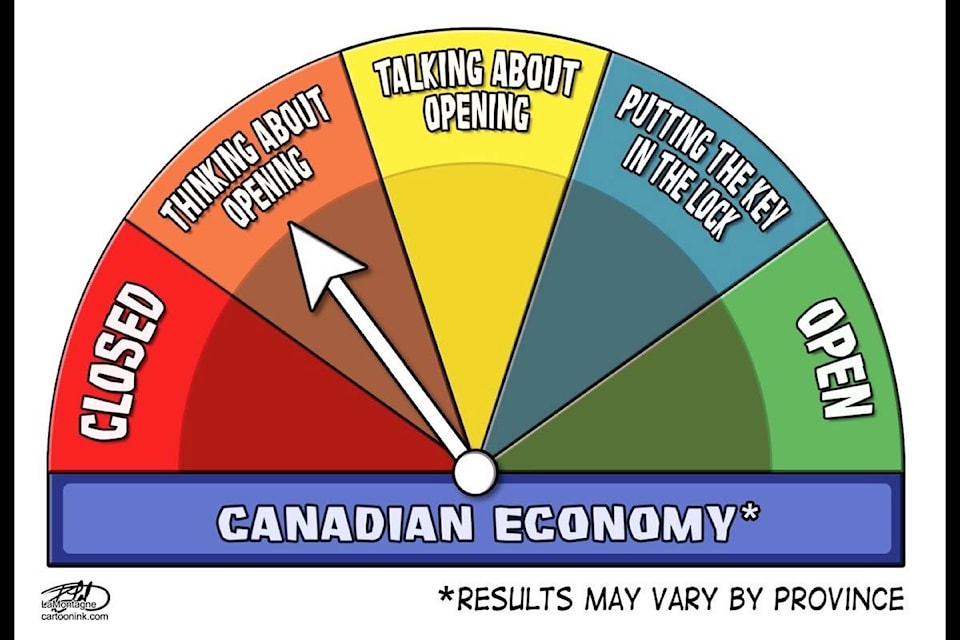No one ever expected a pandemic to sort out Canada’s eternal, federal-provincial power struggles.
But the COVID-19 crisis has become a case study in the power of provinces in this often-fragmented federation — especially now that the nation is talking about how to emerge from lockdown.
Who speaks for Canada? At other turning points in this country’s history, that has been a very controversial question. In this pandemic, the answer is clear and decidedly non-contentious. It’s the provinces.
“The provinces have the authority to determine what is in their best interest,” Prime Minister Justin Trudeau said on Monday, as Ontario and Quebec became the latest provinces to roll out their staged recovery plans.
“It’s not up to the federal government to check or oversee the provinces, and there are areas of jurisdiction, and much of this falls within their areas of jurisdiction.
“They have the responsibility to do what is right for their citizens. Every province is in different situations. Regions within the province are in different situations and I have full confidence in the premiers of the provinces and territories to move forward in a way that is right for them.”
Veterans of Canada’s long constitutional battles might recall how Trudeau’s father, Pierre, stood up for a strong central government in his time, saying that Ottawa should be more than a “head waiter to the provinces” and that Canada was not simply a “community of communities.”
But it would be difficult for any of the premiers to argue right now that big, bad Ottawa is forcing pandemic-relief plans on the provinces.
Quite the reverse is true, in fact — provinces are successively stepping forward with their own plans for coming out of the pandemic, even before the federal government has issued anything like national guidelines or standards.
This reality stands in contrast to what we’ve seen south of the border, where President Donald Trump issued federal guidelines first, only to see states such as Georgia casually reopening on their own anyway, blithely heedless of the Trump plan.
Here in Canada, it appears that national standards remain a work in progress, with Trudeau saying on Monday that they would probably be out in a matter of days.
In the meantime, though, Saskatchewan and New Brunswick trotted out their recovery road maps on Friday, and Ontario and Quebec unveiled their strategies on Monday.
The Saskatchewan and New Brunswick plans were released before premiers talked on their weekly phone call with Trudeau on Friday.
Canada’s two largest provinces held off until after that conversation, which was all about how the country would emerge from a virus that is playing out in very different ways all over the country.
The COVID-19 virus may not respect borders, or even national constitutions, but it has developed a knack for highlighting what a diverse country we are. Team Canada, in a pandemic, is Team Many Canadas.
Deputy Prime Minister Chrystia Freeland said on Monday that Canada’s national guidelines for pandemic recovery (or “pandexit,” as some are now calling it) would be based on three overall principles: the plans must be gradual, based on science and “collaborative.”
Like the Ontario road map issued on Monday, it’s unlikely that Ottawa will ever issue dates or timelines, even rough ones. Rather, we’re more likely to see a set of national conditions under which citizens and businesses can emerge from lockdown. These conditions are likely to include:
Evidence of a significant decline in the cases of COVID-19 in the preceding days and weeks.
Adequate testing: “Make sure you’re doing enough testing for your situation and have a plan to do more,” Trudeau said on Monday.
Workplace safety guidelines in place to ensure that physical distancing can be maintained in reopened businesses or public areas. Discussion is apparently still going on about requirements for masks, according to Howard Njoo, the deputy federal public health officer, who said that Ottawa and provincial health officials were talking about this question on Sunday.
It’s probably not quite accurate to see these as conditions, since Ottawa is in no position to enforce the guidelines, as Trudeau himself said on Monday.
Trump is similarly powerless in the U.S. to dictate how the states are going about the business of getting back to post-pandemic business.
Besides, in Canada, no government seems to be in a mood to get into a tug-of-war over national standards, as they often do about the Canada Health Act, or the environment, for that matter.
There’s an old saying that Canada works in practice, but not in theory.
The COVID-19 crisis is an eminently practical one, which may explain why theoretical power struggles just aren’t happening right now.
It only took a virus and a national lockdown to sort out that epic, very Canadian constitutional battle.
Susan Delacourt is a columnist with Torstar Syndication Services.
